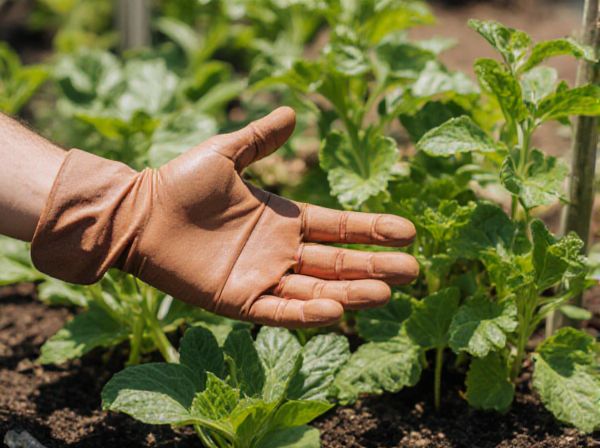
Polyculture Beds vs Monoculture Rows Illustration
Polyculture beds enhance biodiversity by integrating multiple plant species in the same area, which improves soil health and pest resistance naturally. Monoculture rows, though easier to manage mechanically, often lead to soil depletion and increased vulnerability to pests and diseases. Embracing polyculture promotes sustainable yields and ecosystem resilience in permaculture design.
Table of Comparison
| Aspect | Polyculture Beds | Monoculture Rows |
|---|---|---|
| Biodiversity | High - multiple plant species coexist, promoting ecosystem balance | Low - single crop species, limited biodiversity |
| Soil Health | Improved - diverse roots enhance soil structure and nutrient cycling | Degraded - repetitive planting depletes nutrients and compacts soil |
| Pest and Disease Control | Effective - natural pest suppression through plant diversity | Vulnerable - monocultures prone to pest outbreaks and diseases |
| Water Efficiency | Optimized - mixed plants reduce evaporation, improve moisture retention | Lower - exposed soil increases water loss |
| Yield Stability | Stable - diverse crops reduce risk of complete failure | Variable - high risk if crop fails or pests attack |
| Labor Intensity | Moderate - requires management of diverse species | Low - uniform planting and maintenance |
| Sustainability | High - supports long-term ecosystem health and resilience | Low - intensive input often required to maintain yields |
Introduction to Polyculture Beds and Monoculture Rows
Polyculture beds integrate multiple plant species within a shared growing space, enhancing biodiversity, soil health, and pest resistance through complementary interactions. In contrast, monoculture rows involve cultivating a single crop species in uniform rows, which simplifies management but increases vulnerability to pests, diseases, and soil depletion. Understanding these cultivation methods is essential for designing sustainable permaculture systems that balance productivity with ecological resilience.
Core Principles of Polyculture and Monoculture
Polyculture beds integrate multiple plant species in close proximity, enhancing biodiversity, improving soil health through natural nutrient cycling, and reducing pest outbreaks by exploiting complementary plant relationships. Monoculture rows prioritize uniform crops planted in single-species rows, optimizing mechanized farming efficiency but often leading to soil nutrient depletion and increased vulnerability to pests and diseases. Core principles of polyculture emphasize ecological balance and resilience, whereas monoculture focuses on high yields and simplified management.
Soil Health: Polyculture vs Monoculture
Polyculture beds enhance soil health by promoting biodiversity, improving nutrient cycling, and reducing pest outbreaks through the interaction of diverse plant species. Monoculture rows often lead to soil degradation, nutrient depletion, and increased vulnerability to diseases due to repetitive planting of a single crop. Integrating polyculture systems fosters resilient ecosystems and sustainable soil fertility management essential for long-term permaculture success.
Biodiversity and Pest Management
Polyculture beds enhance biodiversity by integrating multiple plant species in a shared space, creating complex ecosystems that naturally reduce pest populations through predator-prey relationships and habitat diversity. Monoculture rows typically support fewer beneficial insects and pollinators, increasing vulnerability to pest outbreaks and requiring more chemical interventions. Diverse plantings in polyculture beds improve soil health and resilience, fostering sustainable pest management without synthetic inputs.
Yield Comparison and Harvest Efficiency
Polyculture beds demonstrate higher yield diversity and resilience compared to monoculture rows, leading to more efficient land use and greater overall productivity per square foot. Diverse planting in polyculture beds enhances nutrient cycling and pest resistance, resulting in more consistent harvests throughout the growing season. Monoculture rows may produce higher uniform yields of a single crop, but they often require more intensive management and are more susceptible to pests and soil depletion.
Water Usage and Resource Conservation
Polyculture beds efficiently conserve water by enhancing soil moisture retention through diverse root structures that reduce evaporation, unlike monoculture rows which often require frequent irrigation due to exposed soil surfaces. The integration of multiple plant species in polyculture systems promotes nutrient cycling and minimizes resource depletion, leading to sustainable water use and reduced fertilizer needs. In contrast, monoculture rows typically demand higher water inputs and synthetic resources, resulting in increased environmental strain.
Labor and Maintenance Requirements
Polyculture beds require less labor and maintenance over time due to natural pest control and improved soil health through diverse plant interactions. Monoculture rows demand more frequent interventions such as pest management, fertilization, and soil amendments to maintain productivity. Efficient labor allocation in polyculture systems reduces overall workload by minimizing the need for chemical inputs and extensive soil disturbance.
Resilience to Plant Diseases and Climate Stress
Polyculture beds enhance resilience to plant diseases and climate stress by promoting biodiversity, which disrupts pest and pathogen cycles and improves soil health through complementary plant interactions. In contrast, monoculture rows create uniform conditions that facilitate rapid disease spread and increase vulnerability to environmental extremes due to genetic and structural uniformity. Integrating diverse species in polyculture systems strengthens ecosystem stability and adaptive capacity, reducing the need for chemical interventions and mitigating climate-related impacts.
Practical Design and Implementation Tips
Polyculture beds enhance soil health and pest resistance by combining diverse plant species that support each other's growth, unlike monoculture rows that often deplete nutrients and attract specific pests. Designing polyculture beds requires careful selection of complementary crops, spatial arrangement to maximize light and nutrient use, and regular monitoring to balance plant competition. Implementing crop rotation and intercropping techniques within these beds promotes sustainable yield and reduces the need for chemical inputs.
Choosing the Best System for Your Permaculture Garden
Polyculture beds enhance biodiversity by combining multiple plant species that support each other's growth, improving soil health and pest resistance, while monoculture rows focus on a single crop type, simplifying management but increasing vulnerability to pests and diseases. Research in permaculture highlights that polycultures mimic natural ecosystems, resulting in higher resilience and sustainable yields over time. Evaluating your garden's space, goals, and maintenance capacity helps determine if the diversity of polyculture beds or the simplicity of monoculture rows best suits your sustainable gardening approach.
Polyculture Beds vs Monoculture Rows Infographic

 gardendif.com
gardendif.com